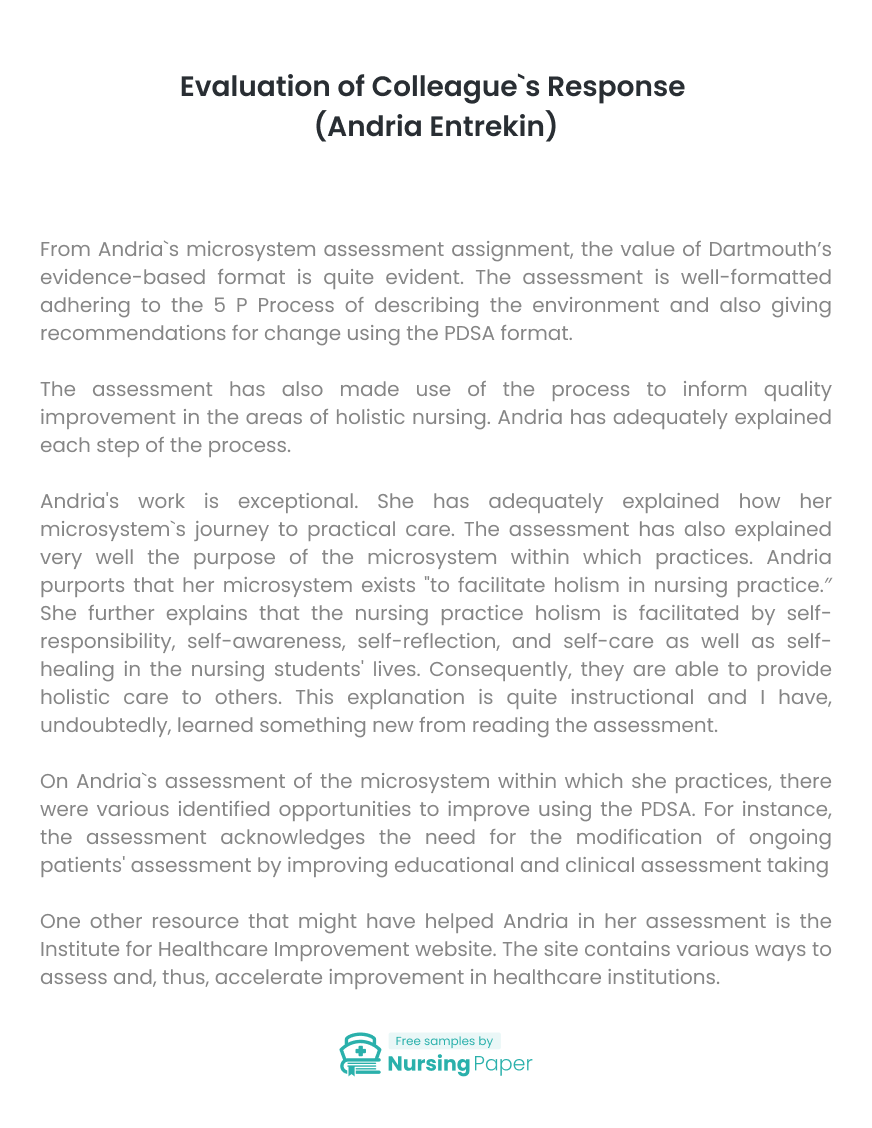
Evaluation of Colleague`s Response (Andria Entrekin)
Introduction
From Andria`s microsystem assessment assignment, the value of Dartmouth’s evidence-based format is quite evident. The assessment is well-formatted adhering to the 5 P Process of describing the environment and also giving recommendations for change using the PDSA format.
The assessment has also made use of the process to inform quality improvement in the areas of holistic nursing. Andria has adequately explained each step of the process.


Andria’s work is exceptional. She has adequately explained how her microsystem`s journey to practical care. The assessment has also explained very well the purpose of the microsystem within which practices. Andria purports that her microsystem exists “to facilitate holism in nursing practice.″ She further explains that the nursing practice holism is facilitated by self-responsibility, self-awareness, self-reflection, and self-care as well as self-healing in the nursing students’ lives. Consequently, they are able to provide holistic care to others. This explanation is quite instructional and I have, undoubtedly, learned something new from reading the assessment.
On Andria`s assessment of the microsystem within which she practices, there were various identified opportunities to improve using the PDSA. For instance, the assessment acknowledges the need for the modification of ongoing patients’ assessment by improving educational and clinical assessment taking
One other resource that might have helped Andria in her assessment is the Institute for Healthcare Improvement website. The site contains various ways to assess and, thus, accelerate improvement in healthcare institutions.

Besides the PDSA, I believe there are alternative evaluation methods for the improvement initiative. Examples of tools I believe could be effective in accelerating the improvement of a microsystem include the Situation-Background-Assessment-Recommendation (SBAR) tool and the Failure Modes and Effect Analysis (FMEA) tool. The FMEA assesses processes to identify any possible failures and, thus, recognize any needs for change. The SBAR tool, on the other hand, ″provides a framework for communication between members of the health care team about a patient’s condition″ (Institute for Healthcare Improvement, 2018).
I acknowledge that health and safety standards can help to improve patients’ safety. As a nurse educator, I believe that emphasizing the biopsychosocial aspect of nursing in the education of prospective nurses might help in improvement empathy, and thus, the overall wellness of patients
I am familiar with quality initiatives such as Lean, Six Sigma, and Lean Six Sigma. Six Sigma quality initiatives consist of 5 sections which can help to ameliorate the microsystem assessment process. The 5 six sigma’s sections (1) define, 2) measure, 3) analyze, 4) improve and 5) control) are quite effective in eliminating defects. The Lean methodology, on the other hand, helps in reducing wastage, whereas Lean Six Sigma incorporates the principles of both Lean and Six Sigma to advocate for ″ customer satisfaction and bottom-line results by reducing variation, waste, and cycle time, while promoting the use of work standardization and flow, thereby creating a competitive advantage″ (Rastogi, 2018).



1. Graves, A. (2012). What is Six Sigma? Retrieved from https://www.sixsigmadaily.com/what-is-six-sigma/
2. Institute for Healthcare Improvement. (2018). Tools. Ihi.org. Retrieved from http://www.ihi.org/resources/Pages/Tools/default.aspx
3. Rastogi, A. (2018). A Brief Introduction to Lean, Six Sigma and Lean Six Sigma. Grey Campus. Retrieved from https://www.greycampus.com/blog/quality-management/a-brief-introduction-to-lean-and-six-sigma-and-lean-six-sigma



The download will start shortly.

The download will start shortly.
 Subject:
Medicine
Subject:
Medicine  Number of pages: 9
Number of pages: 9  Subject:
Nursing
Subject:
Nursing  Number of pages: 2
Number of pages: 2  Subject:
Nursing
Subject:
Nursing  Number of pages: 11
Number of pages: 11  Subject:
Health and Social Care
Subject:
Health and Social Care  Number of pages: 4
Number of pages: 4  Subject:
Health and Social Care
Subject:
Health and Social Care  Number of pages: 3
Number of pages: 3  Subject:
Nursing
Subject:
Nursing  Number of pages: 4
Number of pages: 4  Subject:
Nursing
Subject:
Nursing  Number of pages: 2
Number of pages: 2  Subject:
Health and Social Care
Subject:
Health and Social Care  Number of pages: 3
Number of pages: 3  Subject:
Health and Social Care
Subject:
Health and Social Care  Number of pages: 3
Number of pages: 3  Subject:
Health and Social Care
Subject:
Health and Social Care  Number of pages: 3
Number of pages: 3  Subject:
Nursing
Subject:
Nursing  Number of pages: 2
Number of pages: 2  Subject:
Medicine
Subject:
Medicine  Number of pages: 8
Number of pages: 8  Subject:
Medicine
Subject:
Medicine  Number of pages: 7
Number of pages: 7  Subject:
Nursing
Subject:
Nursing  Number of pages: 4
Number of pages: 4  Subject:
Nursing
Subject:
Nursing  Number of pages: 4
Number of pages: 4 
